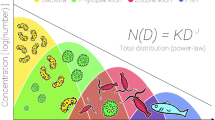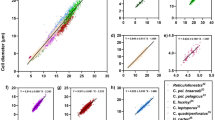Abstract
We describe a procedure for measuring the thickness and mass of calcite particles that works for most calcite particles <4.5-μm thick. The calcite particles are observed in cross-polarized light, which enables the light transmitted through the calcite particles to be correlated with their thickness. Three polarizing planes are used to minimize the darkening of crystals at some orientations (black cross). This allows direct measurement of the thickness without recourse to a transfer function. This procedure has been used recently to determine the degree of calcification of coccoliths, which provides an indicator of ocean acidification. It takes only a few minutes per sample, and it is an improvement over the former protocol, which did not allow measurement of the thickness and mass of particles thicker than 1.5 μm.
This is a preview of subscription content, access via your institution
Access options
Subscribe to this journal
Receive 12 print issues and online access
$259.00 per year
only $21.58 per issue
Buy this article
- Purchase on Springer Link
- Instant access to full article PDF
Prices may be subject to local taxes which are calculated during checkout









Similar content being viewed by others
References
Beaufort, L. et al. Sensitivity of coccolithophores to carbonate chemistry and ocean acidification. Nature 476, 80–84 (2011).
Beltran, C., de Rafelis, M., Person, A., Stalport, F. & Renard, M. Multiproxy approach for determination of nature and origin of carbonate micro-particles so-called 'micarb' in pelagic sediments. Sediment. Geol. 213, 64–76 (2009).
Minoletti, F., Hermoso, M. & Gresier, V. Separation of sedimentary micron-sized particles for palaeoceanography and calcareous nannoplankton biogeochemistry. Nat. Protoc. 4, 14–24 (2008).
Beaufort, L., Couapel, M.J.J., Buchet, N., Claustre, H. & Goyet, C. Calcite production by coccolithophores in the south east Pacific Ocean. Biogeosciences 5, 1101–1117 (2008).
Beaufort, L. & Heussner, S. Coccolithophorids on the continental slope of the Bay of Biscay, I. Production, transport and contribution to mass fluxes. Deep Sea Res. II 46, 2147–2174 (1999).
Young, J. & Ziveri, P. Calculation of coccolith volume and its use in calibration of carbonate flux estimates. Deep Sea Res. 47, 1679–1700 (2000).
Hassenkam, T., Johnsson, A., Bechgaard, K. & Stipp, S.L.S. Tracking single coccolith dissolution with picogram resolution and implications for CO2 sequestration and ocean acidification. Proc. Natl. Acad. Sci. USA 108, 8571–8576 (2011).
Stoll, H.M. & Shimizu, N. Micropicking of nannofossils in preparation for analysis by secondary ion mass spectrometry. Nat. Protoc. 4, 1038–1043 (2009).
Takahashi-Shimase, K. & Nakashima, S. Shape changes of calcareous nannofossils upon aqueous dissolution as revealed by atomic force microscope measurements. Geophys. Res. L. 31, L14313 (2004).
Beaufort, L. Weight estimates of coccoliths using the optical properties (birefringence) of calcite. Micropaleontol. 51, 289–298 (2005).
Grelaud, M., Schimmelmann, A. & Beaufort, L. Coccolithophore response to climate and surface hydrography in Santa Barbara Basin, California, AD 1917-2004. Biogeosciences 6, 2025–2039 (2009).
Engel, A. et al. Testing the direct effect of CO2 concentration on a bloom of the coccolithophorid Emiliania huxleyi in mesocosm experiments. Limnol. Oceanogr. 50, 493–507 (2005).
Beaufort, L., Probert, I. & Buchet, N. Effects of acidification and primary production on coccolith weight: implications for carbonate transfer from the surface to the deep ocean. Geochem. Geophys. Geosyst. 8, Q08011 (2007).
Michel-Levy, A. & Lacroix, A. Les Minéraux des Roches. 1: Application des Méthodes Minéralogiques et Chimiques à leur Étude Microscopique. 2: Données Physiques et Optiques (Librairie Polytechnique Baudry, 1888).
Sorensen, B.B. A revised Michel-Lévy interference colour chart based on first-principles calculations. Eur. J. Mineral. 25, 5–10 (2013).
Fuertes, M.A., Flores, J.-A. & Sierro, F.J. A new technique for observing calcareous nannofossils: methodology and application. (Oral presentation at International Nannoplankton Association, 15–19 September 2013, Reston, Virginia, USA). Abstract in J. Nannoplankton Res. 33, 59 (2013).
Bollmann, J. Technical note: weight approximation of single coccoliths inferred from retardation estimates using a light microscope equipped with a circular polariser – (the CPR Method). Biogeosciences Discuss. 10, 11155–11179 (2013).
Cubillos, J.C., Henderiks, J., Beaufort, L., Howard, W.R. & Hallegraeff, G.M. Reconstructing calcification in ancient coccolithophores: individual coccolith weight and morphology of Coccolithus pelagicus (sensu lato). Marine Micropaleontol. 92–93, 29–39 (2012).
Giraudeau, J. & Beaufort, L. Coccolithophores from extant populations to fossil assemblages. in Developments in Marine Geology Vol. 1 (eds. Hilaire-Marcel, C. & de Vernal, A.) 409–439 (Elsevier, 2007).
Beaufort, L. Adaptation of the random settling method for quantitative studies of calcareous nannofossils. Micropaleontol. 37, 415–418 (1992).
Rottenfusser, R., Price, S.P. & Davidson, M.W. Microscope Alignment for Köhler Illumination http://zeiss-campus.magnet.fsu.edu/tutorials/basics/microscopealignment/index.html.
Beaufort, L. & Dollfus, D. Automatic recognition of coccoliths by dynamical neural network. Mar. Micropaleontol. 51, 57–73 (2004).
Henriksen, K., Stipp, S.L.S., Young, J.R. & Bown, P.R. Tailoring calcite: nanoscale AFM of coccolith biocrystals. Am. Mineral. 88, 2040–2044 (2003).
Saruwatari, K., Ozaki, N., Nagasawa, H. & Kogure, T. Comparison of crystallographic orientations between living (Emiliania huxleyi and Gephyrocapsa oceanica) and fossil (Watznaueria barnesiae) coccoliths using electron microscopes. Am. Mineral. 93, 1670–1677 (2008).
Young, J., Didymus, J.M., Bown, P.R., Prins, B. & Mann, S. Crystal assembly and phylogenetic evolution in heterococcoliths. Nature 356, 516–518 (1992).
Acknowledgements
We thank M.-P. Aubry and J. Henderiks for useful discussions. This work has received financial support from the EU Seventh Framework program Past4Future and from the Agence Nationale de la Recherche under project ANR-12-B06-0007 (CALHIS).
Author information
Authors and Affiliations
Contributions
L.B. conceived the different aspects of this protocol and wrote the manuscript. N.B. commented on the manuscript, established the equation for the color camera and wrote codes for the color thickness calculation. Y.G. wrote the codes for microscope automation and wrote most of the codes for image analysis. All authors contributed to the protocol and its writing by frequent discussions as well as manuscript reading and correcting.
Corresponding author
Ethics declarations
Competing interests
The authors declare no competing financial interests.
Integrated supplementary information
Supplementary Figure 1 The Michel-Lévy Interference Color Chart.
This is Figure 2 of Michel-Levy, A. & Lacroix, A. Les Minéraux des roches. 1 : application des méthodes minéralogiques et chimiques à leur étude microscopique. 2 : données physiques et optiques. (Librairie polytechnique Baudry, 1888). It has been found in http://www.modernmicroscopy.com/main.asp?article=15&page=1, a web page written by John Gustav Delly in 2003.
Supplementary information
The Michel-Lévy Interference Color Chart.
This is Figure 2 of Michel-Levy, A. & Lacroix, A. Les Minéraux des roches. 1 : application des méthodes minéralogiques et chimiques ´ leur étude microscopique. 2 : données physiques et optiques. (Librairie polytechnique Baudry, 1888). It has been found in http://www.modernmicroscopy.com/main.asp?article=15&page=1, a web page written by John Gustav Delly in 2003. (PDF 123 kb)
Supplementary Methods
CalciProbe.exe: a macro using the described protocol. (PDF 47 kb)
Supplementary Data
The CalciProbe.exe macro file. (ZIP 712 kb)
Rights and permissions
About this article
Cite this article
Beaufort, L., Barbarin, N. & Gally, Y. Optical measurements to determine the thickness of calcite crystals and the mass of thin carbonate particles such as coccoliths. Nat Protoc 9, 633–642 (2014). https://doi.org/10.1038/nprot.2014.028
Published:
Issue Date:
DOI: https://doi.org/10.1038/nprot.2014.028
This article is cited by
-
Cyclic evolution of phytoplankton forced by changes in tropical seasonality
Nature (2022)
-
Magnetically tunable and stable deep-ultraviolet birefringent optics using two-dimensional hexagonal boron nitride
Nature Nanotechnology (2022)
-
Integrated sensing from the synergetic color change of the center/brush of cholesteric liquid crystal particles
Science China Materials (2022)
-
High resolution spatial analyses of trace elements in coccoliths reveal new insights into element incorporation in coccolithophore calcite
Scientific Reports (2020)
-
X-ray nanotomography of coccolithophores reveals that coccolith mass and segment number correlate with grid size
Nature Communications (2019)
Comments
By submitting a comment you agree to abide by our Terms and Community Guidelines. If you find something abusive or that does not comply with our terms or guidelines please flag it as inappropriate.



